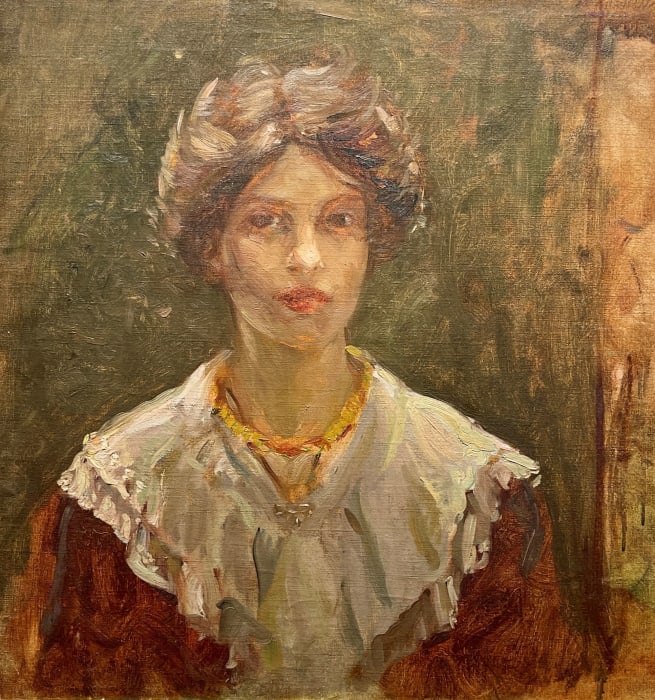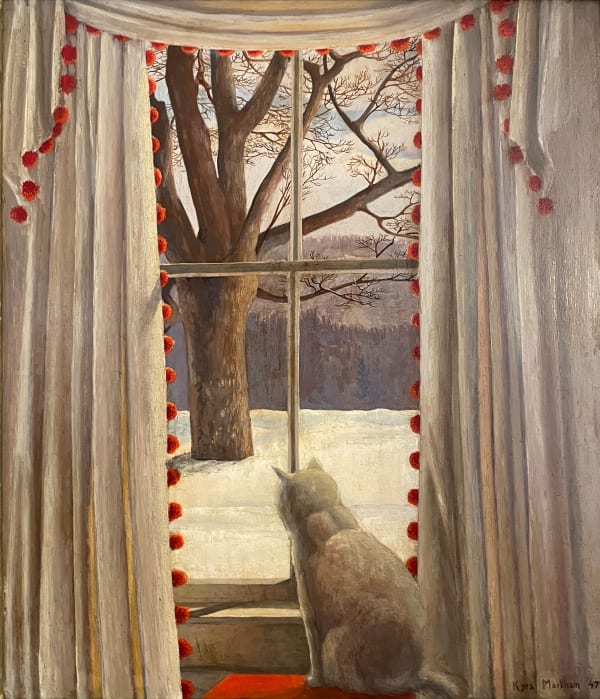Works
Biography
Theresa F. Bernstein was born in Philadelphia in 1895 to cultured, middle-class immigrant parents. She studied at the Philadelphia School of Design for Women, from which she graduated in 1911 with an award for general achievement. From Daniel Garber, her most memorable teacher, she carried forward a plein-air landscape painting with startling color contrasts and bright accents of light. After a brief enrollment at the Art Students League in New York, where she took life and portraiture classes with William Merritt Chase, she traveled for a second time to Europe with her mother, her first trip abroad having been made in 1905. Never a formal student of Robert Henri, she nonetheless embraced his philosophy of depicting the city's everyday drama. "Exposed during both tours to the latest adventures in modernism being investigated in these foreign art capitals, Bernstein was strongly impressed on this 1912 visit by the work of Franz Marc, Edvard Munch, and Wassily Kandinsky, admiring their anti-naturalistic palette and novel departures from other eye-pleasing painting conventions."
She returned to New York with renewed vigor in her ambition to record the larger, expressive power of the city, rather than to dilute that visual confrontation into finely tuned details. Bernstein gravitated to subjects where urban spaces fostered the intersection of citizens from all strata of New York society: scenes commonplace to the waterfront, streets, trolleys, and centers of public recreation ranging from theater lobbies to Coney Island. Her studio location near Bryant Park offered Bernstein the virtues of a distinctive setting in which to test her newly formed ideas about painting and a guaranteed cross section of New Yorkers seeking air, light, and company. She was also known for harbors, beaches, children, still-life and fish.
An art critic once wrote "Bernstein brought the sum of her academic training and visual knowledge of art to the cityscapes she began to generate in the aftermath of the 1913 Armory Show, which seemed again to disorient modern painting only five years after the "Eight" had made their initial splash in New York's art world." Her rapid, fluid brushwork, innovative color play, and fresh approach earned her praise in 1919 as "a woman painter who paints like a man." Ill-considered as that tribute seems today, the comparison acknowledged her solid footing as a member of the "Ash Can School of urban realists" whose work was garnering critical esteem in the early part of the century and from whom Bernstein "crafted her own variant of a "virile" sensibility to chronicle contemporary New York on canvas."
Bernstein was a member of the American Print Makers Society; the National Association of Woman Artists; Boston Printmakers Society; North Shore Art Association; Society of American Etchers; Philadelphia PA; Rockport Art Association; Gloucester Society of Artists; Connecticut Academy of Fine Art; Society of Independent Artists and others. Awards bestowed upon her include: Philadelphia Plastic Club; French institute of Arts and Science; National Association of Woman Artists, 1949, 1951,1955; Society of Graphic Artists, 1953;American Color Printmakers Society prize; French Institute of Arts and Letters, 1938; National Arts Club Prize and many others. She is said to have had over fifty solo shows.
She returned to New York with renewed vigor in her ambition to record the larger, expressive power of the city, rather than to dilute that visual confrontation into finely tuned details. Bernstein gravitated to subjects where urban spaces fostered the intersection of citizens from all strata of New York society: scenes commonplace to the waterfront, streets, trolleys, and centers of public recreation ranging from theater lobbies to Coney Island. Her studio location near Bryant Park offered Bernstein the virtues of a distinctive setting in which to test her newly formed ideas about painting and a guaranteed cross section of New Yorkers seeking air, light, and company. She was also known for harbors, beaches, children, still-life and fish.
An art critic once wrote "Bernstein brought the sum of her academic training and visual knowledge of art to the cityscapes she began to generate in the aftermath of the 1913 Armory Show, which seemed again to disorient modern painting only five years after the "Eight" had made their initial splash in New York's art world." Her rapid, fluid brushwork, innovative color play, and fresh approach earned her praise in 1919 as "a woman painter who paints like a man." Ill-considered as that tribute seems today, the comparison acknowledged her solid footing as a member of the "Ash Can School of urban realists" whose work was garnering critical esteem in the early part of the century and from whom Bernstein "crafted her own variant of a "virile" sensibility to chronicle contemporary New York on canvas."
Bernstein was a member of the American Print Makers Society; the National Association of Woman Artists; Boston Printmakers Society; North Shore Art Association; Society of American Etchers; Philadelphia PA; Rockport Art Association; Gloucester Society of Artists; Connecticut Academy of Fine Art; Society of Independent Artists and others. Awards bestowed upon her include: Philadelphia Plastic Club; French institute of Arts and Science; National Association of Woman Artists, 1949, 1951,1955; Society of Graphic Artists, 1953;American Color Printmakers Society prize; French Institute of Arts and Letters, 1938; National Arts Club Prize and many others. She is said to have had over fifty solo shows.
Press
Exhibitions
Enquire







